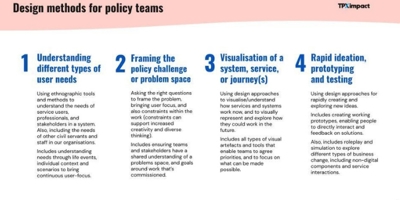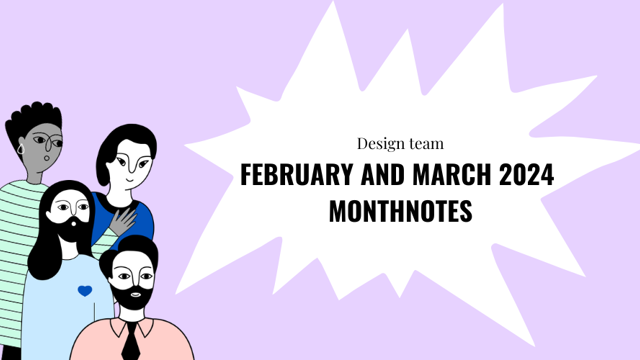Recently, we had the privilege of attending the latest in a series of Cross Government Policy Lab events for the London Policy and Strategy Network, where we presented to a diverse group of professionals ideas from Ben Holliday’s book Multiplied: How Digital Transformation Can Deliver More Impact for the Public Sector.
The goal of the session was to present our design enablers, or ‘multipliers’ and discuss how they can be applied to the policy design space, supported by the introduction of new ways of working, tools, and methods from user centred design.
We began with an introductory talk from Ben Holliday, who talked about design methods for policy teams. Vicky Brown then presented a case study from the work we did with the Department for Health and Social Care (DHSC) showing an application of the design methods for policy.

Discussing design methods for policy
In the second half of the session, together with Joe Bramall's support, Martin Wright and I ran a practical discussion that helped participants go deeper into applying design methods for policy. Facilitated by members of our TPXimpact design team, participants discussed how design methods could be applied to their own organisations and teams, while sharing experiences of the barriers and enablers to bringing user centred design approaches in policy spaces.
The discussions that followed were insightful and highlighted several key themes. There was a clear desire for policy to be ambitious and forward thinking, but there are blockers to that; Several groups touched on the need for a push for expertise and resources to harness the power of design for policy, as well as a shared feeling of overwhelm and being unsure of where to start, not understanding what is needed, or who to bring on board for the journey.
We discussed how adopting design in smaller ways was opening the door to more ambitious undertakings, for example repurposing design artefacts for communicating policy, such as one participant who adapted the ‘Business Model Canvas’ template to communicate policy intent. Another talked about the importance of problem framing, and even reframing to create common issues to create buy-in from different stakeholders, mitigate baked-in assumptions and challenge solution-focused mindsets.
We also explored the perception of design in policy. One participant noted that design doesn't always look like one thing – while certain artefacts seem well-known, design is more flexible and can take many forms to drive impact. This could be a key observation when looking at ways to bring design into the policy space.
There was also discussion of ways of working and how to bring along those established in more traditional ways in policy into a more ‘designerly’ way of working. This was seen both as a barrier as well as opportunity to sensitively implement design for policy.
Related to that, a concern was that individuals not familiar with design may procure for and only want to focus on the delivery of specified products over engaging with adaptable processes and outcomes. While such work helps familiarise people with design, it often needs skilled practitioners who can bring together tangible delivery with taking small steps towards wider change.
The need for design in policy spaces
We agreed that bringing design to policy spaces is not only possible but needed, and has the potential to deliver many advantages. Yet, it requires enablers such as bringing in the right expertise, framing shared problems amongst stakeholders, making a case for resources and getting buy-in at all levels of the business.
The session was an illuminating exploration of the intersection between design and policy. We came away with a renewed optimism that the strategic application of design could be a powerful tool in the policy space and while challenges persist, the potential impact of applying design to policy work is immense, and it’s worth exploring further to make it possible – the journey may be slow, but the impact promises to be transformative.
You can view the video of the event online, with the full presentations and discussions of these themes.
Our recent design blog posts
Transformation is for everyone. We love sharing our thoughts, approaches, learning and research all gained from the work we do.

From Manila to London: Navigating cultures in the TPXimpact Design Academy
Ron Digao shares his journey to our Design Academy and his experience in the programme so far this year.
Read more
